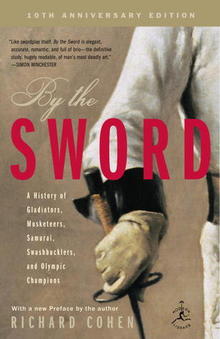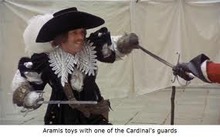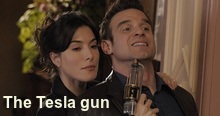Is That Your Sword, Or Are You Just Happy to See Me?
 I love sword-fights. By which I mean I love them in movies and on TV. Not so much in books. Mostly in books they take too long, and illustrate more how much research the writer has done and not so much the moving ahead of the story. And that’s how swords and sword fighting came to mind when I started thinking about what real life things do and don’t happen in fiction, or in movies or TV. If you’d like to see what I’ve already said about this, look here, and here.
I love sword-fights. By which I mean I love them in movies and on TV. Not so much in books. Mostly in books they take too long, and illustrate more how much research the writer has done and not so much the moving ahead of the story. And that’s how swords and sword fighting came to mind when I started thinking about what real life things do and don’t happen in fiction, or in movies or TV. If you’d like to see what I’ve already said about this, look here, and here.
So, in the spirit of what does and doesn’t happen in real life vs TV or movies – or even books – just what happens with people’s swords when they aren’t using them to kill someone? And what about other weapons? As I’ve suggested before, this type of thing is fairly easily handled in books. More easily than, say, why characters never (ie. hardly ever) go to the bathroom. In books, when they’re not using them, characters simply sheath their swords, or hang them from their harnesses, or hang them up by the belt on a hook. Or put them down on a table. As the reader, your eyes are directed elsewhere, and you rarely give it another thought.
Sure, sometimes a writer will have a character clean their sword, or other weapons. But there are reasons for this. One, it gives the characters something to do with their hands while dialogue is taking place. Two, how the cleaning gets done tells the reader something about the character’s personality.
 Though it happens for comic effect on film, very rarely in books will characters trip over their own swords. Nor do they trip others – at least not by accident. And that’s the point, characters are not clumsy by accident, not with their swords, nor with anything else. (In fact, from the point of view of the author, there are no accidents in fiction. Everything is done on purpose. But I digress.)
Though it happens for comic effect on film, very rarely in books will characters trip over their own swords. Nor do they trip others – at least not by accident. And that’s the point, characters are not clumsy by accident, not with their swords, nor with anything else. (In fact, from the point of view of the author, there are no accidents in fiction. Everything is done on purpose. But I digress.)
In movies or TV, things can get more complicated. It’s harder to direct the viewers’ eyes away from something that should be right in front of them, all the time. Like a guy’s sword.
Period drama, and fantasy of the sword-and-sorcery variety, handle this by making the swords part of the costume, as indeed they were in the days when gentlemen always wore them. In that sense, swords can be fashion statements. Even the word “rapier” as Richard Cohen tells us in his marvelous book By the Sword, comes from the Spanish phrase “espada ropera” or “dress sword.” And talking of tripping over your own sword, Cohen tells us that when fashionably long rapiers began to cause too many accidents, Elizabeth I passed a proclamation limiting their length.
In any case, people have been “wearing” swords for centuries, and, from our point of view more significant, they’ve been “wearing” them on stage pretty much as long. So actors, whether of the stage or screen variety, have a long history of learning how to move with a sword.
 Should be easier with guns, right? Well, sure. Maybe they haven’t the history of swords, but they’re smaller, for one thing. In detective novels, characters like Robert Parker’s Spenser, or Robert Crais’ Elvis Cole, simply tell you what type of holster they’re using, and what jacket they’re wearing to cover their gun. In westerns – or Firefly – characters wear their guns openly in holsters.
Should be easier with guns, right? Well, sure. Maybe they haven’t the history of swords, but they’re smaller, for one thing. In detective novels, characters like Robert Parker’s Spenser, or Robert Crais’ Elvis Cole, simply tell you what type of holster they’re using, and what jacket they’re wearing to cover their gun. In westerns – or Firefly – characters wear their guns openly in holsters.
But it’s not always that easy.
A friend of ours was one of the art directors for the TV series Warehouse 13. He was specifically responsible for the design of two items, a communication device called a Farnsworth, and an energy gun called a Tesla. “Make them look cool,” was what he was told, and make them look cool is what he did. Unfortunately it proved to be impossible to make a gun look cool and fit into anyone’s costume pockets at the same time. What did they do? When they need their Teslas, the actors simply reach “behind” them, and come out with the gun. I never noticed it, and I don’t think I would even have thought about it, if my friend hadn’t pointed it out.
Come to think of it, I have a scene early in The Sleeping God, when my mercenary characters, Dhulyn and Parno, have to disarm themselves. They play it for dramatic effect, and take about a page and half to do it. No one has ever asked me where all those weapons could have been hidden. So you see how easy this can be in the reality of a novel. You’ve experienced how it works in film reality. Do you think it could happen in real reality?
Violette Malan is the author of the Dhulyn and Parno series of sword and sorcery adventures (now available in omnibus editions), as well as the Mirror Lands series of primary world fantasies. As VM Escalada, she is writing the upcoming Halls of Law series. Visit her website: www.violettemalan.com.
Have you ever heard of Hammerspace as a trope, Violette? http://tvtropes.org/pmwiki/pmwiki.php/Main/Hammerspace
R.A. Salvatore covers some of these points in his writing. He does a good job of keeping the reader informed of where the weapons are during a fight without making it tedious.
While i still enjoy his fight scenes 11 years and 35+ books later and i kind of skim his fight scenes now to get back to the story.
The thing I always try to keep track of is speed of deployment. Drawing a sword, or a knife, or really anything is something you have to train if you want to do it quickly and without fumbling. There’s a whole subset of the Japanese sword arts dedicated to batto-jitsu, or the techniques of drawing the sword.
Mainly, this means I tend not have characters with weapons slung across their shoulders.
@ Glenn: I find the people who do it best are the ones who are fencers — or martial artists of some other kind — themselves. While I’ve studied Judo, I have to rely on expert input for practically everything else. sometimes I’ll get a friend to pace out a fight for me.
I do find that I tend to skim over fight scenes when reading, if they seem to be taking a long time. I’ll carefully go over the first couple, in case there’s something relating to character in there, but if I find the author isn’t doing that, then I tend to skim the rest.
@ Sean: Hanging down the back is also an iffy one, isn’t it? I sometimes have my characters carry spare weapons that way, but I really try not to have them use that method routinely.
Thank you both for your comments.
I’ve been an a book signing where someone asked bob where he first got the information for his fight scenes.
He said that both his kids where into fencing growing up and he used to ask the instructors questions all the time.
I can vouch for the sheer inconvenience of transporting more than one sword. What with the oddly shaped bags, when we turn up at our hall to do German longsword it’s more like a meeting of Goth snowboarders than Highlander.
Often, in later Medieval Europe, gentlemen had pages to carry their swords. In cities, this was often a legal requirement and – in London at least – there was a strict rule about one page bearing a sword per sword owner.
Hiding guns:
https://www.youtube.com/watch?v=TMA2zkodZCk
I like that concept, M’Harold!
“With a snap of fingers my Sword Boy steps forward and offers my 2 1/2 hand hilt first. I grab the hilt and the lad dances back as with a dramatic pull I unsheathe the bloodthirsty blade.”
Gene Wolfe’s Book of the New Sun is one work in which sword-care is given a lot of attention. It seems like Severian is always sharpening Terminus Est or oiling it or worrying about damaging the blade. It made me notice it in other stories when the swords emerge from nowhere like light sabers and vanish again once the action is over.
Some of my favorite fight scenes are in the Burroughs Barsoom books, although I know they’re completely implausible for many, many reasons.
(And given Martians’ penchant for strapping many, many weapons onto the miniscule amount of clothing they wear, I can only assume most of them have some interesting self-inflicted scars.)
Of all the shows I’ve seen play with the Hammerspace trope, The Backyardigans did it most brazenly. The “Eureka!” episode carried the running gag farthest.
One of my favorite “print” swordfights is between Oscar Gordon and The Eater of Souls in Robert Heinlein’s Glory Road.
“”Mostly in books they take too long, and illustrate more how much research the writer has done and not so much the moving ahead of the story. “”
And that is what I recently wrote about when John posted the recent reminder of Poul Anderson’s “On Thud and Blunder” classic essay. More of an anniversary celebration of the article.
My IMO is that that essay is taken as a hard and fast rule versus a guideline. Yeah, poor research could harm mediocre writing. However too much research and – well the quote I cited from you says it all. AND – a good writer can have ol Gnorts the Barbarian fight off dozens of the King’s Guards with a 50lb wet noodle if he really writes epic good.
Some things are done best in some mediums, some in others. Essentially “A Picture is worth a thousand words” – well to convey a rapid sword fight… Even a minimalist approach could be tedious, something I’m working on actually. Essentially the fight is again the surface, the real plot element is the conflict between the characters, or the character’s movement in the story – and what does that represent? Is it desperation as the barbarian hero is fighting to rescue the princess, fighting dozens of low skilled but still deadly cultists as the third moon sets and the unholy priest will sacrifice her to some Lovecraft like thing? Is it sorrow and tragedy as the Steampunk Metropolis burns in civil war and two brothers of the royal house, one steadfast with the oppressive upper class the other joining the rebels fight, and it represents in a way man’s continual fall due to his jealousy and greed, the brother’s fighting with one to surely kill the other Cain’s sin?
@ Glenn: The best advice I ever got was from a fencing instructor who was doing a demo at a Confusion in Detroit. Among the things he told me was who got it right, and who got it wrong, in films. He also recommended a video called “Masters of Defense” which I’ve never been able to find.
@ M. Harold: I don’t always carry a cane, but when I do I think about how awkward it must sometimes be to carry a sword, and I think how lucky I am to have canes that either fold or telescope, when it comes to packing.
I heard the one sword per person per page rule was something started by the Union of Pages.
@ princejvustin: I hadn’t heard of this, thanks for bringing it to my attention.
@ Raphael: I can’t believe I’d actually forgotten about that, big Wolfe fan that I am. It’s been so long since I read that particular series that maybe I can be excused. I have to say that I did _not_ take particular note of it at the time, but perhaps that’s because Wolfe’s writing is so seamless.
@ Joe H.I loved the fight scenes in the Barsoom books — they were probably my first experience of sword fighting in print. It never occurred to me when I first read them to wonder where and how any of the characters were carrying their weapons. Since then, of course, “ouch”.
@ Sarah: embarrassed to say I’d never heard of this series, since I am Canadian, but perhaps I can be excused since I have no children, nor nieces or nephews of the age appropriate to introduce me. Nor does my friend who used to work at Nelvana work there anymore. Thanks for introducing me to it.
I think the whole trope of “where’s the hardware?” when it comes to comics and cartoons is worthy of a post of its own, but it can’t be done by me.
@ Thomas: That one is really a classic in my books as well. Of course, it bears out what I say above that the people who do it best are fencers themselves. The whole fight, in all its detail, is also extremely important plot-wise, and for the clarification of Oscar’s character. Top score on all counts, I think.
@ TW: thanks so much for this, it makes me feel a lot better about the amount of stuff Dhulyn and Parno have stashed — and where.
@ GreenGestalt: I could not agree more. When you say that the fight is the surface, and the real plot element the conflict between the characters, you’ve hit it right on the head.
I’ve had a couple of people — one of them my own agent — complain of Dhulyn and Parno that they don’t fight anywhere near enough, or that their fights aren’t long enough, especially considering that they’re such amazing masters at what they do. I maintain that it’s precisely _because_ they’re such masters that their fights with anyone but another Mercenary Brother would be very short indeed. It’s not about the fighting, it’s about the action.
This?
http://www.amazon.com/Masters-Defence-Civilian-Swordsmanship-1500-1800/dp/B002QYG5BG
And on YouTube:
https://www.youtube.com/watch?v=B8kyXa-_J8A
I remember seeing listings for the video in the Museum Replicas, Ltd. catalog back in the day, but never got around to actually ordering anything from them.
That’s got to be it, Joe. I remember looking for it everywhere back when I still had a VHS player, and finally giving up because I couldn’t find it. Now I see that it’s being offered in VHS, which, alas, doesn’t do me any good. I’ll check out the youtube listing and see what I can see.
Thanks!
You’re welcome! And I’m glad I finally got to see it myself lo these many years later … I watched the YouTube version myself earlier this morning. The transfer is rough, but it was still interesting information.
@jason
The rule of one page with one sword is more to do with the obvious hack: “These are my pages, one for each of my one hundred swords. Oh, are you finding them intimidating?”